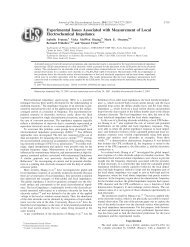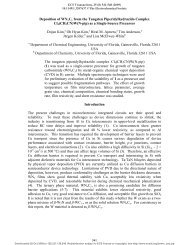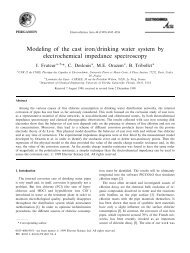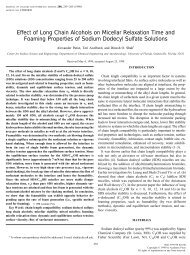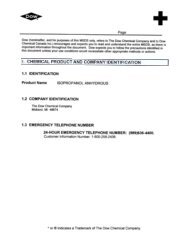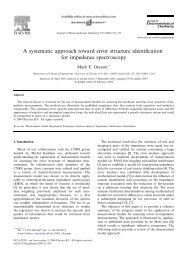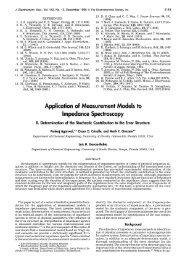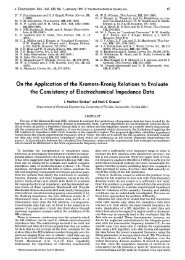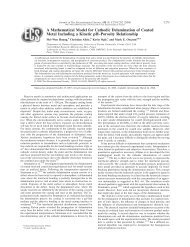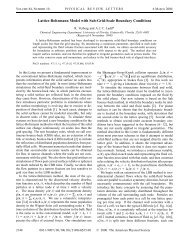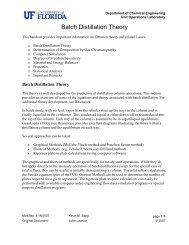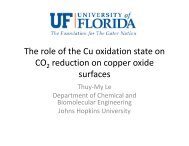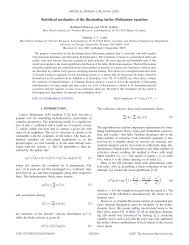Stability of Sodium Dodecyl Sulfate Micelles in the Presence of a ...
Stability of Sodium Dodecyl Sulfate Micelles in the Presence of a ...
Stability of Sodium Dodecyl Sulfate Micelles in the Presence of a ...
Create successful ePaper yourself
Turn your PDF publications into a flip-book with our unique Google optimized e-Paper software.
J. Phys. Chem. B 2001, 105, 7133-7138<br />
7133<br />
<strong>Stability</strong> <strong>of</strong> <strong>Sodium</strong> <strong>Dodecyl</strong> <strong>Sulfate</strong> <strong>Micelles</strong> <strong>in</strong> <strong>the</strong> <strong>Presence</strong> <strong>of</strong> a Range <strong>of</strong> Water-Soluble<br />
Polymers: A Pressure-Jump Study<br />
Dibakar Dhara and D<strong>in</strong>esh O. Shah*<br />
Center for Surface Science and Eng<strong>in</strong>eer<strong>in</strong>g, Departments <strong>of</strong> Chemical Eng<strong>in</strong>eer<strong>in</strong>g and Anes<strong>the</strong>siology,<br />
UniVersity <strong>of</strong> Florida, Ga<strong>in</strong>esVille, Florida 32611<br />
ReceiVed: August 24, 2000; In F<strong>in</strong>al Form: NoVember 17, 2000<br />
The effects <strong>of</strong> a range <strong>of</strong> nonionic and ionic water-soluble polymers on <strong>the</strong> micellar stability <strong>of</strong> sodium<br />
dodecyl sulfate were <strong>in</strong>vestigated by <strong>the</strong> pressure-jump method. The presence <strong>of</strong> polymer that <strong>in</strong>teracts with<br />
SDS was found to decrease <strong>the</strong> micellar stability drastically. Surface activity <strong>of</strong> <strong>the</strong> polymers was correlated<br />
with <strong>the</strong>ir ability to reduce <strong>the</strong> micellar stability. The decrease <strong>in</strong> micellar stability was expla<strong>in</strong>ed by <strong>the</strong><br />
formation <strong>of</strong> premicellar aggregates (or submicelles) <strong>of</strong> surfactants <strong>in</strong> <strong>the</strong> presence <strong>of</strong> polymer, which facilitated<br />
<strong>the</strong> micelle formation-dis<strong>in</strong>tegration process.<br />
Introduction<br />
In any situation where surfactant must adsorb at a newly<br />
created <strong>in</strong>terface, whe<strong>the</strong>r it is at air/liquid or solid/liquid<br />
<strong>in</strong>terface, it is supplied to <strong>the</strong> new <strong>in</strong>terface by <strong>the</strong> diffusion <strong>of</strong><br />
monomer molecules. When a surface is suddenly expanded, <strong>the</strong><br />
stability <strong>of</strong> <strong>the</strong> micelles affect <strong>the</strong> ability <strong>of</strong> <strong>the</strong> solution to supply<br />
<strong>the</strong> monomers to <strong>the</strong> new surface. The less stable <strong>the</strong> micelles,<br />
<strong>the</strong> greater <strong>the</strong> monomer flux to <strong>the</strong> new surface/<strong>in</strong>terface will<br />
be. Hence, <strong>the</strong> stability <strong>of</strong> micelles should play a significant<br />
role <strong>in</strong> processes where new <strong>in</strong>terfaces are constantly generated.<br />
It has been experimentally verified that <strong>the</strong> micellar stability<br />
<strong>in</strong>deed plays an important role <strong>in</strong> various technological processes<br />
such as foam<strong>in</strong>g, 1 bubble dynamics, 2 wett<strong>in</strong>g time <strong>of</strong> cotton, 3<br />
solubilization and detergency, 4 emulsion droplet size, 5 and th<strong>in</strong><br />
film stability. 6 Therefore, understand<strong>in</strong>g <strong>the</strong> factors affect<strong>in</strong>g<br />
micellar stability is key to <strong>in</strong>fluenc<strong>in</strong>g <strong>the</strong> dynamic surface or<br />
<strong>in</strong>terfacial tension and also <strong>the</strong> technological processes controlled<br />
by <strong>the</strong>m.<br />
Shah and co-workers have showed that <strong>the</strong> stability <strong>of</strong> sodium<br />
dodecyl sulfate micelles can be affected by additives such as<br />
short and long cha<strong>in</strong> alcohols, 7,8 oppositely charged surfactants, 9<br />
tetraalkylammonium chlorides, 10 and antifoams. 11 However, <strong>the</strong><br />
effect <strong>of</strong> polymers on <strong>the</strong> micellar stability has not been explored<br />
well. S<strong>in</strong>ce <strong>the</strong> polymers are added <strong>in</strong> various surfactant<br />
formulations, it will be very <strong>in</strong>terest<strong>in</strong>g to <strong>in</strong>vestigate <strong>the</strong><br />
dynamic behavior <strong>of</strong> surfactant micelles <strong>in</strong> <strong>the</strong> presence <strong>of</strong><br />
polymers.<br />
Besides, <strong>the</strong> surfactant-polymer systems <strong>in</strong> aqueous solution<br />
are also <strong>in</strong>trigu<strong>in</strong>g from both fundamental as well as practical<br />
po<strong>in</strong>ts <strong>of</strong> view. These complex mixtures f<strong>in</strong>d extensive <strong>in</strong>dustrial<br />
applications <strong>in</strong> areas related to m<strong>in</strong>eral process<strong>in</strong>g, foam<strong>in</strong>g<br />
control, medic<strong>in</strong>e, food, detergency, enhanced oil recovery, etc.<br />
They are also <strong>of</strong> <strong>in</strong>terest <strong>in</strong> formulation and condition<strong>in</strong>g <strong>of</strong><br />
cosmetics, biological, pharmaceutical, and f<strong>in</strong>e chemistry applications.<br />
From <strong>the</strong> fundamental po<strong>in</strong>t <strong>of</strong> view, understand<strong>in</strong>g<br />
<strong>the</strong> nature <strong>of</strong> <strong>the</strong> surfactant-polymer <strong>in</strong>teractions that lead to<br />
<strong>the</strong> formation <strong>of</strong> a complex and <strong>the</strong> physical structure and<br />
stability <strong>of</strong> this complex is fasc<strong>in</strong>at<strong>in</strong>g and not clearly established<br />
* Correspond<strong>in</strong>g author. Phone: (352) 392-0877.Fax: (352) 392-0127.<br />
E-mail: shah@che.ufl.edu.<br />
yet. Thus <strong>in</strong>teraction between surfactants and polymers has been<br />
<strong>the</strong> subject <strong>of</strong> active research for <strong>the</strong> last three decades and it<br />
has also been focused on <strong>in</strong> some <strong>of</strong> <strong>the</strong> recent reviews. 12,13<br />
Most studies on polymer-surfactant <strong>in</strong>teraction are based upon<br />
equilibrium data, i.e., <strong>the</strong> effect <strong>of</strong> polymers on <strong>the</strong> critical<br />
micellar concentration <strong>of</strong> <strong>the</strong> surfactant and <strong>the</strong> aggregation<br />
number <strong>of</strong> <strong>the</strong> micelles. 14-17 The effect <strong>of</strong> polymers on <strong>the</strong><br />
dynamic behavior <strong>of</strong> micellar solutions has not been studied <strong>in</strong><br />
depth. 18-21 Such a study is important <strong>in</strong> understand<strong>in</strong>g <strong>the</strong><br />
dynamic behavior <strong>of</strong> surfactant micelles <strong>in</strong> <strong>the</strong> presence <strong>of</strong><br />
polymers and also <strong>in</strong> understand<strong>in</strong>g <strong>the</strong> fundamentals <strong>of</strong><br />
polymer-surfactant <strong>in</strong>teraction. In a recent paper we have<br />
reported <strong>the</strong> effect <strong>of</strong> poly(ethylene glycols) on sodium dodecyl<br />
sulfate micelles <strong>in</strong> <strong>the</strong> concentration range <strong>of</strong> 50-600 mM. 22<br />
The present paper is an extension <strong>of</strong> that work, <strong>in</strong>tended as a<br />
detailed study <strong>of</strong> <strong>the</strong> effect <strong>of</strong> a range <strong>of</strong> water-soluble polymers<br />
on <strong>the</strong> micellar stability over a wide range <strong>of</strong> surfactant<br />
concentrations.<br />
Experimental Section<br />
Materials. SDS (99% purity), from Sigma Chemical Co., was<br />
used as received. The source, average molecular weights (when<br />
available), and abbreviations <strong>of</strong> <strong>the</strong> polymers used <strong>in</strong> this study<br />
are listed <strong>in</strong> Table 1. The average molecular weights are as given<br />
by <strong>the</strong> suppliers. The polydispersity data are not available.<br />
Deionized water was used <strong>in</strong> all <strong>the</strong> experiments.<br />
Pressure-Jump Experiments. The slow relaxation time (τ 2 )<br />
<strong>of</strong> SDS micelles was measured us<strong>in</strong>g a pressure-jump apparatus<br />
with conductivity detection from Dia-Log GmbH (Duesseldorf,<br />
Germany) by record<strong>in</strong>g <strong>the</strong> change <strong>in</strong> conductivity that results<br />
from micelle formation or dis<strong>in</strong>tegration. 24,25 The surfactant<br />
solution was pressurized up to 100-130 bar and <strong>the</strong> solution<br />
was allowed to reach its new equilibrium state (at high cmc).<br />
Subsequently, <strong>the</strong> pressure was suddenly released to ambient<br />
pressure (<strong>in</strong>itial cmc). The slow relaxation time τ 2 was <strong>the</strong>n<br />
calculated from <strong>the</strong> exponential decay <strong>in</strong> electrical conductivity.<br />
The conductivity <strong>of</strong> <strong>the</strong> surfactant sample solution held <strong>in</strong> <strong>the</strong><br />
conductivity cell attached to <strong>the</strong> pressure chamber was compared<br />
to a reference cell conta<strong>in</strong><strong>in</strong>g KCl solution <strong>of</strong> <strong>the</strong> same<br />
conductivity. In <strong>the</strong> pressure-jump <strong>in</strong>strument used here, <strong>the</strong><br />
pressure falls follow<strong>in</strong>g <strong>the</strong> rupture <strong>of</strong> a th<strong>in</strong> metal diaphram,<br />
10.1021/jp003072l CCC: $20.00 © 2001 American Chemical Society<br />
Published on Web 06/22/2001
7134 J. Phys. Chem. B, Vol. 105, No. 29, 2001 Dhara and Shah<br />
TABLE 1: Sources and Molecular Weights <strong>of</strong> Polymers and Prote<strong>in</strong>s Used <strong>in</strong> This Study<br />
polymer abbrev source avg molecular weight<br />
nonionic<br />
methyl cellulose MC Fisher<br />
hydroxyethyl cellulose HEC PolyScience 90 000-105 000<br />
ethyl(hydroxyethyl) cellulose E230 Akzo Nobel<br />
(Bermocoll E 230 FQ)<br />
ethyl(hydroxyethyl) cellulose E411 Akzo Nobel<br />
(Bermocoll E 411 FQ)<br />
hydroxypropyl cellulose HPC PolyScience low MW<br />
hydroxypropyl methyl cellulose HPMC Aldrich 86 000<br />
hydroxybutyl methyl cellulose HBMC Aldrich<br />
dextran PolyScience 15 000-20 000<br />
poly(ethylene glycol) PEG Scientific Polymer Products 6800<br />
poly(propylene glycol) PPG Aldrich ca. 1000<br />
poly(N-v<strong>in</strong>yl pyrrilidone) PVP Aldrich 10 000<br />
poly(v<strong>in</strong>yl alcohol), 98% hydrolyzed PVA Aldrich 13 000-23 000<br />
poly(acrylamide) PAAm PolyScience 10 000<br />
poly(N-isopropylacrylamide) PNIPA syn<strong>the</strong>sized 23 40 000<br />
anionic<br />
poly(acrylic acid) PAA PolyScience 150 000<br />
poly(acrylic acid), Na salt PAA Na Aldrich 15 000<br />
carboxymethyl cellulose, Na CMC Na PolyScience 80 000<br />
cationic<br />
Quatris<strong>of</strong>t Polymer LM-200 LM-200 Amerchol<br />
(polyquart<strong>in</strong>ium 24)<br />
Polymer JR 400 JR400 Amerchol<br />
(polyquart<strong>in</strong>ium 10)<br />
poly(ethyleneim<strong>in</strong>e) PEI PolyScience 10 000<br />
Figure 1. Mechanism for <strong>the</strong> two relaxation times, τ 1 and τ 2, for a<br />
surfactant solution above critical micelle concentration (cmc).<br />
which takes 50-100 µs. So it is not possible to measure <strong>the</strong><br />
fast relaxation time (τ 1 ) (which is on <strong>the</strong> order <strong>of</strong> microseconds)<br />
with our <strong>in</strong>strument. Moreover, we are ma<strong>in</strong>ly <strong>in</strong>terested <strong>in</strong> τ 2 ,<br />
because it is related to <strong>the</strong> micellar stability. All τ 2 values were<br />
obta<strong>in</strong>ed at 25 °C.<br />
Surface tensions <strong>of</strong> <strong>the</strong> polymer solutions were measured<br />
by <strong>the</strong> Wilhelmy plate method, consist<strong>in</strong>g <strong>of</strong> a plat<strong>in</strong>um blade<br />
suspended from a force transducer with output connected to a<br />
voltmeter for digital display. Before each measurement, <strong>the</strong><br />
plat<strong>in</strong>um plate was cleaned by heat<strong>in</strong>g to a red/orange color<br />
with a Bunsen burner.<br />
Results and Discussion<br />
Dynamic properties <strong>of</strong> micelles are characterized by two<br />
relaxation processes (Figure 1). The first relaxation time (τ 1 ),<br />
which is on <strong>the</strong> order <strong>of</strong> microseconds, is associated with <strong>the</strong><br />
exchange <strong>of</strong> monomers with micellar aggregates. The slow<br />
relaxation time (τ 2 ), which is on <strong>the</strong> order <strong>of</strong> milliseconds to<br />
seconds, is associated with complete formation-dis<strong>in</strong>tegration<br />
<strong>of</strong> micelles. τ 1 and τ 2 are related with two important statistical<br />
parameters <strong>of</strong> <strong>the</strong> micellar system, namely, <strong>the</strong> “residence time”<br />
<strong>of</strong> a surfactant <strong>in</strong> micelles and <strong>the</strong> stability (average “lifetime”)<br />
<strong>of</strong> micelles, respectively.<br />
Figure 2. Effect <strong>of</strong> PEG, MC, and PNIPA on <strong>the</strong> slow relaxation time<br />
(τ 2) <strong>of</strong> SDS <strong>of</strong> different concentrations: (]) SDS only, (0) PEG<br />
(0.01%), (×) PNIPA (0.01%), and (4) MC (0.01%).<br />
Figure 2 shows <strong>the</strong> effect <strong>of</strong> PEG, MC, and PNIPA on <strong>the</strong><br />
slow relaxation time τ 2 <strong>of</strong> SDS micelles <strong>in</strong> <strong>the</strong> concentration<br />
range <strong>of</strong> 50-600 mM. All three polymers are reported to <strong>in</strong>teract<br />
strongly with SDS. 12-16,26-29 In <strong>the</strong> absence <strong>of</strong> polymer, τ 2<br />
showed an <strong>in</strong>itial <strong>in</strong>crease with <strong>in</strong>creas<strong>in</strong>g SDS concentration<br />
but started decreas<strong>in</strong>g above 200 mM. These results are well <strong>in</strong><br />
agreement with previous <strong>in</strong>vestigations. 1,30 The appearance <strong>of</strong><br />
a maxima <strong>in</strong> τ 2 has been expla<strong>in</strong>ed by <strong>the</strong> onset <strong>of</strong> formation<br />
<strong>of</strong> nonspherical micelles. 1 Ano<strong>the</strong>r explanation for <strong>the</strong> occurrence<br />
<strong>of</strong> <strong>the</strong> maximum at 200 mM was provided by Kahlweit<br />
et al. 30 They represent <strong>the</strong> reaction path for <strong>the</strong> formation <strong>of</strong><br />
micelles by two parallel resistors, R 1 and R 2 , where R 1 refers
<strong>Stability</strong> <strong>of</strong> <strong>Sodium</strong> <strong>Dodecyl</strong> <strong>Sulfate</strong> <strong>Micelles</strong> J. Phys. Chem. B, Vol. 105, No. 29, 2001 7135<br />
Figure 3. Effect <strong>of</strong> cellulose derivatives at different concentration on<br />
<strong>the</strong> slow relaxation time (τ 2) <strong>of</strong> 200 mM SDS: (b) dextran, (0) HEC,<br />
(4) E230, (×) E411, (]) MC, (*) HPC, (O) HPMC, and (+) HBMC.<br />
to <strong>the</strong> formation <strong>of</strong> micelle by stepwise addition <strong>of</strong> monomers<br />
and R 2 refers to micelle formation by coagulation <strong>of</strong> submicellar<br />
aggregates. At low concentrations, R 2 is very high due to<br />
electrostatic repulsion between <strong>the</strong> submicellar aggregates, and<br />
<strong>the</strong>refore, R 1 determ<strong>in</strong>es <strong>the</strong> τ 2 . However, R 1 <strong>in</strong>creases with an<br />
<strong>in</strong>crease <strong>in</strong> counterion concentration, whereas R 2 decreases due<br />
to a decrease <strong>in</strong> electrostatic repulsion between submicellar<br />
aggregates. With<strong>in</strong> a limited concentration range, both resistors<br />
become comparable and τ 2 passes through a maximum. Figure<br />
2 shows that <strong>the</strong> addition <strong>of</strong> polymers decreases <strong>the</strong> stability <strong>of</strong><br />
SDS micelles for all concentrations and this decrease <strong>in</strong> τ 2 is<br />
most effective <strong>in</strong> <strong>the</strong> case <strong>of</strong> 200 mM SDS, which formed <strong>the</strong><br />
most stable micelle <strong>in</strong> <strong>the</strong> absence <strong>of</strong> any polymer. Therefore,<br />
to compare this micelle destabiliz<strong>in</strong>g effect <strong>of</strong> different polymers,<br />
fur<strong>the</strong>r experiments with o<strong>the</strong>r polymers were restricted<br />
on 200 mM SDS solution. It is to be mentioned that addition<br />
<strong>of</strong> salts actually did not reduce <strong>the</strong> maximum value <strong>of</strong> τ 2 , <strong>in</strong>stead<br />
addition <strong>of</strong> salt shifted <strong>the</strong> SDS concentrations lower, until, at<br />
high salt concentrations, τ 2 appears to decrease start<strong>in</strong>g from<br />
<strong>the</strong> cmc onward. 30,31<br />
In Figure 2 it appears to be that <strong>the</strong> maximum <strong>in</strong> τ 2 is shifted<br />
from 200 mM for <strong>the</strong> b<strong>in</strong>ary SDS/water system to nearly 150<br />
mM SDS as PEG, MC, and PNINA are added to <strong>the</strong> solution.<br />
This could possibly be due to formation <strong>of</strong> nonspherical micelles<br />
at 150 mM SDS <strong>in</strong> <strong>the</strong> presence <strong>of</strong> polymers. Syn<strong>the</strong>tic<br />
macromolecules do not possess any preferential three-dimensional<br />
geometry; <strong>the</strong>y are more flexible to assume any random<br />
conformation. For example, a PEG cha<strong>in</strong> <strong>in</strong> aqueous solution<br />
behaves as a highly mobile molecule with a large exclusion<br />
volume. 32 Upon SDS b<strong>in</strong>d<strong>in</strong>g, <strong>the</strong> hydrodynamic volume <strong>of</strong><br />
polymer cha<strong>in</strong>s is expected to <strong>in</strong>crease fur<strong>the</strong>r due to polyelectrolyte<br />
behavior. Thus, <strong>in</strong> <strong>the</strong> presence <strong>of</strong> polymer <strong>the</strong> effective<br />
free volume <strong>of</strong> water available for <strong>the</strong> free micelles to disperse<br />
is considerably less compared to polymer-free solution; as a<br />
result, <strong>the</strong> maximum pack<strong>in</strong>g <strong>of</strong> spherical micelles and subsequent<br />
nonspherical micelle formation are expected to be at lower<br />
concentration than 200 mM SDS.<br />
Figure 3 plots τ 2 <strong>of</strong> 200 mM SDS as function <strong>of</strong> concentration<br />
<strong>of</strong> various cellulose derivatives and dextran. All <strong>the</strong> polymers<br />
decreased τ 2 drastically, except dextran and HEC. Among <strong>the</strong>se<br />
polymers, only dextran and HEC reportedly do not <strong>in</strong>teract or<br />
Figure 4. Slow relaxation time (τ 2) <strong>of</strong> 200 mM SDS as a function <strong>of</strong><br />
molarity <strong>of</strong> repeat<strong>in</strong>g unit <strong>of</strong> syn<strong>the</strong>tic polymers (v<strong>in</strong>ylic): (O) PAAm,<br />
(·) PVA, (4) PVP, (0) PPG, (+) PNIPA, and (]) PEG.<br />
very weekly <strong>in</strong>teract with SDS. 33-35 The cellulose derivatives<br />
and dextran can be ranked accord<strong>in</strong>g to <strong>the</strong>ir ability to affect<br />
<strong>the</strong> τ 2 <strong>of</strong> SDS as follows: HPC > HBMC > HPMC > MC ><br />
E230 > E411 . HEC > dextran.<br />
As stated above, <strong>the</strong> polymers <strong>in</strong>teract<strong>in</strong>g strongly with SDS<br />
decrease τ 2 . So <strong>the</strong> above rank<strong>in</strong>g <strong>of</strong> <strong>the</strong> polymers should also<br />
be applicable to <strong>the</strong>ir strength <strong>of</strong> <strong>in</strong>teraction with SDS <strong>in</strong> water.<br />
This rank<strong>in</strong>g more or less tally with <strong>the</strong> critical aggregation<br />
concentration (cac) values (def<strong>in</strong>ed as <strong>the</strong> critical surfactant<br />
concentration for <strong>the</strong> start <strong>of</strong> aggregation) <strong>in</strong> <strong>the</strong> presence <strong>of</strong><br />
<strong>the</strong>se polymers. 33<br />
Figure 4 shows <strong>the</strong> effect <strong>of</strong> various syn<strong>the</strong>tic polymers<br />
(v<strong>in</strong>ylic) on <strong>the</strong> τ 2 <strong>of</strong> 200 mM SDS. In this case <strong>the</strong> molarity <strong>of</strong><br />
polymer repeat<strong>in</strong>g units was used for proper comparison among<br />
<strong>the</strong> polymers. PNIPA and PEG reduced τ 2 drastically; PVP,<br />
PPG, and PVA moderately, and PAAm not at all. Interaction<br />
<strong>of</strong> SDS with PEG, PNIPA, PVP, PPG, and PVA is welldocumented.<br />
12,26,36-37 These polymers can be ranked accord<strong>in</strong>g<br />
to <strong>the</strong>ir effect on <strong>the</strong> τ 2 <strong>of</strong> 200 mM SDS as follows: PEG ∼<br />
PNIPA . PPG > PVP > PVA . PAAm.<br />
As <strong>in</strong> <strong>the</strong> case <strong>of</strong> cellulose derivatives, this rank<strong>in</strong>g should<br />
also be applicable to <strong>the</strong>ir strength <strong>of</strong> <strong>in</strong>teraction with SDS. This<br />
rank<strong>in</strong>g is fairly comparable with <strong>the</strong> cac values <strong>in</strong> <strong>the</strong> presence<br />
<strong>of</strong> <strong>the</strong>se polymers, except for <strong>the</strong> pair PEG/PVP. 12,26,38 It can<br />
be mentioned that PVP is known to have a lower cac than PEG,<br />
which was attributed to <strong>the</strong> greater hydrophobicity <strong>of</strong> PVP. 13<br />
But <strong>the</strong> hydrophobicity <strong>of</strong> PVP is not so different than that <strong>of</strong><br />
PEG (as shown later <strong>in</strong> Figure 8), which can only be responsible<br />
for <strong>the</strong> low cac <strong>of</strong> PVP. While study<strong>in</strong>g <strong>the</strong> gel-electrophoretic<br />
behavior <strong>of</strong> <strong>the</strong> PEG-SDS complex, it was reported that unlike<br />
PEGs, PVPs could not be separated accord<strong>in</strong>g to <strong>the</strong>ir molecular<br />
weight by SDS-poly(acrylamide) gel electrophoresis due to <strong>the</strong><br />
weaker nature <strong>of</strong> <strong>the</strong> PVP-SDS complex than <strong>the</strong> PEG-SDS<br />
complex. 39,40 The τ 2 results reported here are consistent with<br />
this <strong>in</strong>terpretation.<br />
Figure 5 shows <strong>the</strong> effect <strong>of</strong> anionic polymers on <strong>the</strong> stability<br />
<strong>of</strong> 200 mM SDS. While PAA decreased <strong>the</strong> relaxation time,<br />
<strong>the</strong> effect <strong>of</strong> PAA Na and CMC Na was not significant.<br />
Somasundaran et al. 41 reported <strong>the</strong> presence <strong>of</strong> a def<strong>in</strong>ite<br />
<strong>in</strong>teraction between PAA and SDS; it has also been reported
7136 J. Phys. Chem. B, Vol. 105, No. 29, 2001 Dhara and Shah<br />
Figure 5. Effect <strong>of</strong> anionic polymers as a function <strong>of</strong> molarity <strong>of</strong><br />
repeat<strong>in</strong>g unit <strong>of</strong> polymers on <strong>the</strong> slow relaxation time (τ 2) <strong>of</strong> 200 mM<br />
SDS: (4) CMC Na, (0) PAA Na, and (]) PAA.<br />
Figure 7. Relation between surface activity <strong>of</strong> cellulose derivatives<br />
and <strong>the</strong>ir effect on <strong>the</strong> slow relaxation time (τ 2) <strong>of</strong> 200 mM SDS: (0)<br />
τ 2 and (O) surface tension.<br />
Figure 8. Relation between surface activity <strong>of</strong> <strong>the</strong> syn<strong>the</strong>tic polymers<br />
and <strong>the</strong>ir effect on <strong>the</strong> slow relaxation time (τ 2) <strong>of</strong> 200 mM SDS: (b)<br />
τ 2 and (O) surface tension.<br />
Figure 6. Effect <strong>of</strong> cationic polymers at different concentration on<br />
<strong>the</strong> slow relaxation time (τ 2) <strong>of</strong> 200 mM SDS: (]) LM-200, (0) JR<br />
400, and (4) PEI.<br />
that SDS does not <strong>in</strong>teract with PAA Na and CMC Na by Zana<br />
et, al. 42 and Schwuger et al., 43 respectively. These results aga<strong>in</strong><br />
<strong>in</strong>dicate that <strong>the</strong> polymers that <strong>in</strong>teract strongly with SDS<br />
decrease its micellar stability. Figure 6 shows <strong>the</strong> effect <strong>of</strong><br />
cationic polymers on <strong>the</strong> stability <strong>of</strong> 200 mM SDS. All <strong>the</strong> three<br />
polymers reduced <strong>the</strong> stability, <strong>the</strong> effect be<strong>in</strong>g a maximum for<br />
PEI. The strong <strong>in</strong>teraction between PEI and SDS is well-studied<br />
by W<strong>in</strong>nik and co-workers 44 and Wyn-Jones et al.; 45 <strong>in</strong>teractions<br />
between JR 400 and LM-200 with SDS are also reported. 46,47<br />
The strong <strong>in</strong>teraction between oppositely charged polymers and<br />
SDS is not surpris<strong>in</strong>g, s<strong>in</strong>ce very strong electrostatic forces <strong>of</strong><br />
attraction are <strong>in</strong>volved.<br />
The k<strong>in</strong>etics <strong>of</strong> <strong>the</strong>se processes has been evaluated by<br />
Aniansson and co-workers. 48,49 The “residence time” <strong>of</strong> <strong>the</strong><br />
surfactant monomer <strong>in</strong> micelles is related to τ 1 and is equal to<br />
n/k - , where n is <strong>the</strong> mean aggregation number and k - is <strong>the</strong><br />
rate constant <strong>of</strong> dissociation <strong>of</strong> a surfactant from a micelle. τ 2<br />
is given by <strong>the</strong> follow<strong>in</strong>g expression 48<br />
1<br />
) n2<br />
τ 2 R[ A 1 + F2<br />
n (A tot - A 1 ] -1<br />
)<br />
where n is <strong>the</strong> aggregation number, F is <strong>the</strong> half-width <strong>of</strong> <strong>the</strong><br />
Gaussian distribution curve <strong>of</strong> micellar population, A tot is <strong>the</strong><br />
total surfactant concentration, and A 1 is <strong>the</strong> mean monomer<br />
concentration, which is <strong>of</strong>ten approximated as <strong>the</strong> cmc. An<strong>in</strong>asson<br />
and Wall def<strong>in</strong>ed “resistance” R by<br />
R )<br />
s 2<br />
1<br />
∑<br />
s)s 1 +1<br />
k s - [A s ]<br />
where A s and k s - are <strong>the</strong> equilibrium concentration and <strong>the</strong><br />
dissociation rate constant <strong>of</strong> <strong>the</strong> premicellar aggregates hav<strong>in</strong>g<br />
aggregation number s, respectively. The overall rate is assumed<br />
to be limited by a set <strong>of</strong> slow steps <strong>in</strong>volv<strong>in</strong>g several <strong>of</strong> <strong>the</strong><br />
least stable aggregates, that is, values <strong>of</strong> s <strong>in</strong> a range <strong>of</strong> species<br />
<strong>of</strong> aggregation number s 1 + 1 < r < s 2 , where s 1 represents<br />
monomer and s 2 <strong>the</strong> start <strong>of</strong> true micelle formation. Therefore,
<strong>Stability</strong> <strong>of</strong> <strong>Sodium</strong> <strong>Dodecyl</strong> <strong>Sulfate</strong> <strong>Micelles</strong> J. Phys. Chem. B, Vol. 105, No. 29, 2001 7137<br />
as per <strong>the</strong> model, τ 2 value should be sensitive to <strong>the</strong> concentration<br />
<strong>of</strong> premicellar aggregates. S<strong>in</strong>ce dur<strong>in</strong>g <strong>the</strong> slow relaxation<br />
process <strong>the</strong> reaction path from monomers to micelles follows<br />
sequential addition <strong>of</strong> monomers to premicellar aggregates, <strong>the</strong><br />
<strong>in</strong>creased population <strong>of</strong> <strong>the</strong>se <strong>in</strong>termediate premicellar species<br />
will facilitate <strong>the</strong> micelle formation-dissolution process and<br />
decrease <strong>the</strong> value <strong>of</strong> τ 2 .<br />
It is likely that <strong>in</strong> <strong>the</strong> presence <strong>of</strong> a polymer <strong>the</strong>re would be<br />
formation <strong>of</strong> small aggregates <strong>of</strong> SDS by adsorption on <strong>the</strong><br />
polymer cha<strong>in</strong>, i.e., <strong>the</strong>re will be an <strong>in</strong>crease <strong>in</strong> <strong>the</strong> population<br />
<strong>of</strong> smaller surfactant aggregates. This will result <strong>in</strong> a decrease<br />
<strong>in</strong> <strong>the</strong> values <strong>of</strong> “R” and consequently <strong>the</strong> stability <strong>of</strong> micelles.<br />
This could be <strong>the</strong> reason for <strong>the</strong> decreased stability <strong>of</strong> SDS<br />
micelles <strong>in</strong> <strong>the</strong> presence <strong>of</strong> polymers. The greater <strong>the</strong> amount<br />
<strong>of</strong> added polymer, <strong>the</strong> greater <strong>the</strong> effect. The effect is observed<br />
mostly <strong>in</strong> <strong>the</strong> case <strong>of</strong> 200 mM SDS, because at this concentration<br />
<strong>the</strong> stability <strong>of</strong> SDS micelles is a maximum. So any perturbation<br />
<strong>in</strong> <strong>the</strong> stability would be reflected most significantly at this<br />
concentration. This effect should be expected to be greater is<br />
case <strong>of</strong> more hydrophobic polymers, because SDS would b<strong>in</strong>d<br />
more to <strong>the</strong> more hydrophobic polymers.<br />
The polymer-bound surfactant aggregates have a higher<br />
degree <strong>of</strong> dissociation compared to <strong>the</strong> normal micelles. 50 So<br />
addition <strong>of</strong> polymers could also result <strong>in</strong> more free counterions<br />
<strong>in</strong> <strong>the</strong> solution and an <strong>in</strong>crease <strong>in</strong> <strong>the</strong> ionic strength. Accord<strong>in</strong>g<br />
to Kalhweit’s model, this could also be <strong>the</strong> reason for <strong>the</strong><br />
decrease <strong>in</strong> <strong>the</strong> micellar stability due to <strong>the</strong> greater probability<br />
<strong>of</strong> coagulation between premicellar aggregates. But, as mentioned<br />
earlier, it was reported that <strong>the</strong> addition <strong>of</strong> salts shifted<br />
<strong>the</strong> maxima <strong>of</strong> τ 2 , <strong>the</strong> value <strong>of</strong> <strong>the</strong> maximum τ 2 be<strong>in</strong>g <strong>the</strong> same.<br />
In <strong>the</strong> present case <strong>the</strong> maximum value <strong>of</strong> τ 2 is decreased.<br />
Moreover, addition <strong>of</strong> CMC Na and PAA Na did not affect <strong>the</strong><br />
micellar stability considerably. This observation supported that<br />
<strong>the</strong> decrease <strong>in</strong> micellar stability is because <strong>of</strong> polymer-<strong>in</strong>duced<br />
formation <strong>of</strong> small surfactant aggregates. Figure 7 shows <strong>the</strong><br />
value τ 2 <strong>of</strong> 200 mM SDS <strong>in</strong> <strong>the</strong> presence <strong>of</strong> 0.01% (w/v)<br />
cellulose derivatives along with <strong>the</strong>ir surface tension values (<strong>of</strong><br />
surfactant-free polymer solutions). A direct relation between <strong>the</strong><br />
surface activity <strong>of</strong> <strong>the</strong> polymer and its ability to reduce <strong>the</strong><br />
stability <strong>of</strong> SDS micelles is observed. The greater <strong>the</strong> surface<br />
activity <strong>of</strong> <strong>the</strong> polymer, <strong>the</strong> greater will be <strong>the</strong> b<strong>in</strong>d<strong>in</strong>g <strong>of</strong> SDS<br />
on to <strong>the</strong> polymer and <strong>the</strong> value <strong>of</strong> τ 2 would decrease. Figure 8<br />
shows <strong>the</strong> value τ 2 <strong>of</strong> 200 mM SDS <strong>in</strong> <strong>the</strong> presence <strong>of</strong> 0.1%<br />
nonionic syn<strong>the</strong>tic polymers along with <strong>the</strong>ir surface tension<br />
values (<strong>of</strong> surfactant-free polymer solutions). In this case <strong>the</strong>re<br />
is no direct relation between <strong>the</strong> surface activity <strong>of</strong> <strong>the</strong> polymer<br />
and τ 2 values. This <strong>in</strong>dicates that <strong>the</strong> <strong>in</strong>teraction between <strong>the</strong>se<br />
syn<strong>the</strong>tic polymers and SDS is not governed by <strong>the</strong> hydrophobicity<br />
<strong>of</strong> <strong>the</strong> polymers alone. Ra<strong>the</strong>r, electrostatic and/or specific<br />
<strong>in</strong>teraction between <strong>the</strong> surfactant headgroup and <strong>the</strong> polar group<br />
present <strong>in</strong> <strong>the</strong> polymer molecule could be determ<strong>in</strong><strong>in</strong>g <strong>the</strong><br />
strength <strong>of</strong> <strong>in</strong>teraction between SDS and <strong>the</strong>se syn<strong>the</strong>tic<br />
polymers.<br />
Conclusion<br />
The results presented here on <strong>the</strong> effect <strong>of</strong> a range <strong>of</strong> watersoluble<br />
polymers on <strong>the</strong> micellar stability <strong>of</strong> sodium dodecyl<br />
micelles suggest that <strong>the</strong> polymers that <strong>in</strong>teract strongly with<br />
SDS decrease its micellar stability drastically. In fact this can<br />
be used as a tool to probe <strong>the</strong> <strong>in</strong>teract<strong>in</strong>g ability <strong>of</strong> various<br />
polymers with SDS <strong>in</strong> aqueous medium. For <strong>the</strong> nonionic<br />
cellulose derivatives, surface activity determ<strong>in</strong>es <strong>the</strong>ir ability<br />
to <strong>in</strong>teract with SDS and consequently <strong>the</strong>ir ability to make<br />
micelles more labile. For syn<strong>the</strong>tic polymers (v<strong>in</strong>ylic) ei<strong>the</strong>r<br />
specific <strong>in</strong>teractions or electrostatic <strong>in</strong>teractions between polymer<br />
and SDS determ<strong>in</strong>e <strong>the</strong>ir ability to affect micellar stability. The<br />
decrease <strong>in</strong> <strong>the</strong> micellar stability on <strong>in</strong>teraction with polymer is<br />
expla<strong>in</strong>ed by <strong>the</strong> <strong>in</strong>creased population <strong>of</strong> premicellar aggregates<br />
<strong>of</strong> SDS on b<strong>in</strong>d<strong>in</strong>g with <strong>the</strong> polymers.<br />
Acknowledgment. The authors thank <strong>the</strong> NSF-Eng<strong>in</strong>eer<strong>in</strong>g<br />
Research Center for Particle Science & Technology (Grant No.<br />
9402989) for <strong>the</strong>ir support.<br />
References and Notes<br />
(1) Oh, S. G.; Shah, D. O. Langmuir 1991, 7, 1316.<br />
(2) Oh, S. G.; Kle<strong>in</strong>, S. P.; Shah, D. O. AICHE J. 1992, 38, 149.<br />
(3) Oh, S. G.; Shah, D. O. Langmuir 1992, 8, 1232.<br />
(4) Oh, S. G.; Shah, D. O. J. Am. Oil. Chem. Soc. 1993, 70, 673.<br />
(5) Oh, S. G.; Jobalia, M.; Shah, D. O. J. Colloid. Interface Sci. 1993,<br />
156, 511.<br />
(6) Patel S. S.; Kumar, K.; Shah, D. O.; Delf<strong>in</strong>o, J. J. Colloid. Interface<br />
Sci. 1996, 183, 603.<br />
(7) Leung, R.; Shah, D. O. J. Colloid. Interface Sci. 1986, 113, 484.<br />
(8) Patist, A.; Axelberd, T.; Shah, D. O. J. Colloid. Interface Sci. 1998,<br />
208, 259.<br />
(9) Patist, A.; Chhabra, V.; Pagidipati, R.; Shah, R.; Shah, D. O.<br />
Langmuir 1992, 13, 432.<br />
(10) Patist, A.; Huibers, P. D. T.; Deneka, B.; Shah, D. O. Langmuir<br />
1998, 14, 4471.<br />
(11) Jha, B. K.; Patist, A.; Shah, D. O. Langmuir 1999, 15, 3042.<br />
(12) Goddard, E. D. Colloids Surf. 1986, 19, 255.<br />
(13) L<strong>in</strong>dman, B.; Thalberg, K. In Interactions <strong>of</strong> Surfactants with<br />
Polymers and Prote<strong>in</strong>s; Goddard, E. D., Ananthapadmanabhan, K. P., Eds.;<br />
CRC Press: Boca Raton, FL, 1993; p 203.<br />
(14) Jones, M. N. J. Colloid. Interface Sci. 1967, 23, 36. Cabane, B.; J.<br />
Phys. Chem. 1977, 81, 1639.<br />
(15) Schwuger, M. J. J. Colloid. Interface Sci. 1973, 43, 491; Zana, R.;<br />
Lianos, P.; Lang, J. J. Phys. Chem. 1985, 89, 41.<br />
(16) Gao, Z.; Wasylishen, R. E.; Kwak, J. C. T. J. Phys. Chem. 1991,<br />
95, 462.<br />
(17) Dub<strong>in</strong>, P. L.; Gruber, J. H.; Xia, J.; Zhang, H. J. Colloid. Interface<br />
Sci. 1992, 148, 92.<br />
(18) Bloor, D. M.; Wyn-Jones, E. J. Chem. Soc., Faraday Trans. 2.<br />
1982, 78, 657.<br />
(19) Pa<strong>in</strong>ter, D. M.; Bloor, D. M.; Takisawa, N.; Hall, D. G.; Wyn-<br />
Jones, E. J. Chem. Soc., Faraday Trans. 1. 1988, 84, 2087; Gett<strong>in</strong>gs, J.;<br />
Gould, C.; Hall, D. G.; Jobl<strong>in</strong>g, P. L.; Rass<strong>in</strong>g, J. E. Wyn-Jones, E. J. Chem.<br />
Soc., Faraday Trans. 2. 1980, 76, 1535.<br />
(20) D’Aprano, A.; La Mesa, C.; Persi, L. Langmuir 1997, 13, 5876.<br />
(21) Tondre, C. J. Phys. Chem. 1985, 89, 5101.<br />
(22) Dhara, D.; Shah, D. O. Langmuir, <strong>in</strong> press.<br />
(23) Dhara, D.; Chatterji, P. R. Langmuir 1999, 15, 930; Park, T. G.;<br />
H<strong>of</strong>fman, A. S. Macromolecules 1993, 26, 5045.<br />
(24) Knoche, W. In Chemical and Biological Applications <strong>of</strong> Relaxation<br />
Spectrometry; Wyn-Jones, E., Ed.; D. Reidel: Dordrecht, Holland, 1975;<br />
p 91.<br />
(25) Muller, N. In Solution Chemistry <strong>of</strong> Surfactants; Mittal, K. L., Ed.;<br />
Plenum: New York, 1979; Vol. 1, p 267.<br />
(26) Ballerat-Busserolles, K.; Roux-Desgranges, G.; Roux, A. H. Langmuir<br />
1997, 13, 1946.<br />
(27) Ghoreishi, S. M.; Li, Y.; Bloor, D. M.; Warr, J.; Wyn-Jones, E.<br />
Langmuir 1999, 15, 4380.<br />
(28) Jean, B.; Lee, L. T.; Cabane, B. Langmuir 1999, 15, 7585.<br />
(29) Mylonas, Y.; Staikos, G.; Lianos, P. Langmuir 1999, 15, 7172.<br />
(30) Lessner, E.; Teubner, M.; Kahlweit, M. J. Phys. Chem. 1981, 85,<br />
3167.<br />
(31) Kahlweit, M. Pure Appl. Chem. 1981, 53, 2069.<br />
(32) Ryle, A. P. Nature 1965, 206, 1256; Hells<strong>in</strong>g, K. J. Chromatogr.<br />
1968, 36, 170.<br />
(33) S<strong>in</strong>gh, S. K.; Nilsson, S. J. Colloid. Interface Sci. 1999, 213, 133.<br />
S<strong>in</strong>gh, S. K.; Nilsson, S. J. Colloid. Interface Sci. 1999, 213, 152.<br />
(34) Evertsson, H.; Nilsson, S. Carbohydr. Polym. 1998, 35, 135.<br />
(35) Persson, B.; Nilsson, S.; Sundel<strong>of</strong>, L.-O. Carbohydr. Polym. 1996,<br />
29, 127.<br />
(36) Gilyani, T.; Wolfram, E. Colloids Surf. 1981, 3, 181.<br />
(37) Witte, F. M.; Engberts, J. B. F. N. Colloids Surf. 1989, 36, 417.<br />
(38) Breuer, M. M. Robb, I. D. Chem. Ind. 1972, 530.<br />
(39) Dhara. D.; Chatterji, P. R. J. Phys. Chem. B 1999, 103, 8458.<br />
(40) Zimmerman, S. B.; Murphy, L. D. Anal. Biochem 1996, 234, 190.<br />
(41) Maltesh, C.; Somasundaran, P. Colloids Surf. 1992, 69, 167.<br />
(42) B<strong>in</strong>ana-Limbele, W.; Zana, R. Colloids Surf. 1986, 21, 483.
7138 J. Phys. Chem. B, Vol. 105, No. 29, 2001 Dhara and Shah<br />
(43) Schwuger, M. J.; Lange, H. Tenside 1968, 5, 257.<br />
(44) W<strong>in</strong>nik, M. A.; Bystryak, S. M.; Chassenieux, C.; Strashko, V.;<br />
Macdonald, P. M.; Siddiqui, J. Langmuir 2000, 16, 4495.<br />
(45) Li, Y.; Ghoreishi, S. M.; Warr, J.; Bloor, D. M.; Holzwarth, J. F.;<br />
Wyn-Jones, E. Langmuir 2000, 16, 3093.<br />
(46) Goddard, E. D.; Hannan, R. B. J. Colloid. Interface Sci. 1976, 55,<br />
73; Goldraich, M.; Schwartz, J. R.; Burns, J. L.; Talmon, Y. Colloids Surf.<br />
A 1997, 125, 231.<br />
(47) Shub<strong>in</strong>, V. Langmuir 1994, 10, 1093; Shub<strong>in</strong>, V.; Petrov, P.;<br />
L<strong>in</strong>dman, B. Colloid. Polym. Sci. 1994, 272, 1590.<br />
(48) An<strong>in</strong>asson, E. A. G.; Wall, S. N. J. Phys. Chem. 1974, 78, 1024.<br />
(49) An<strong>in</strong>asson, E. A. G.; Wall, S. N.; Almgren, M.; H<strong>of</strong>fmann, H.;<br />
Kielmann, I.; Ulbricht, W. Zana, R.; Lang, J.; Tondre, C. J. Phys. Chem.<br />
1976, 80, 905.<br />
(50) Zana, R.; Lang, J.; Lianos, P. In Microdoma<strong>in</strong>s <strong>in</strong> Polymer<br />
Solutions; Dub<strong>in</strong>, P., Eds.; Plenum: New York, 1985; p 369.



